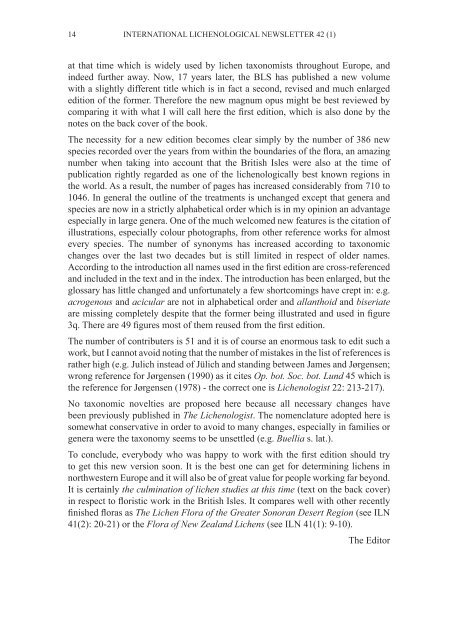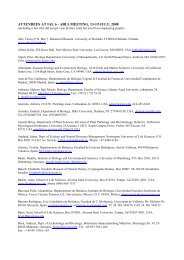international lichenological - International Association for Lichenology
international lichenological - International Association for Lichenology
international lichenological - International Association for Lichenology
Create successful ePaper yourself
Turn your PDF publications into a flip-book with our unique Google optimized e-Paper software.
14 INTERNATIONAL LICHENOLOGICAL NEWSLETTER 42 (1)<br />
at that time which is widely used by lichen taxonomists throughout Europe, and<br />
indeed further away. Now, 17 years later, the BLS has published a new volume<br />
with a slightly different title which is in fact a second, revised and much enlarged<br />
edition of the <strong>for</strong>mer. There<strong>for</strong>e the new magnum opus might be best reviewed by<br />
������������������������������������������������������������������������������������<br />
notes on the back cover of the book.<br />
The necessity <strong>for</strong> a new edition becomes clear simply by the number of 386 new<br />
�����������������������������������������������������������������������������������<br />
number when taking into account that the British Isles were also at the time of<br />
publication rightly regarded as one of the <strong>lichenological</strong>ly best known regions in<br />
the world. As a result, the number of pages has increased considerably from 710 to<br />
1046. In general the outline of the treatments is unchanged except that genera and<br />
species are now in a strictly alphabetical order which is in my opinion an advantage<br />
especially in large genera. One of the much welcomed new features is the citation of<br />
illustrations, especially colour photographs, from other reference works <strong>for</strong> almost<br />
every species. The number of synonyms has increased according to taxonomic<br />
changes over the last two decades but is still limited in respect of older names.<br />
��������������������������������������������������������������������������������������<br />
and included in the text and in the index. The introduction has been enlarged, but the<br />
glossary has little changed and un<strong>for</strong>tunately a few shortcomings have crept in: e.g.<br />
acrogenous and acicular are not in alphabetical order and allanthoid and biseriate<br />
�����������������������������������������������������������������������������������<br />
������������������������������������������������������������������<br />
The number of contributers is 51 and it is of course an enormous task to edit such a<br />
work, but I cannot avoid noting that the number of mistakes in the list of references is<br />
rather high (e.g. Julich instead of Jülich and standing between James and Jørgensen;<br />
wrong reference <strong>for</strong> Jørgensen (1990) as it cites Op. bot. Soc. bot. Lund 45 which is<br />
the reference <strong>for</strong> Jørgensen (1978) - the correct one is Lichenologist 22: 213-217).<br />
No taxonomic novelties are proposed here because all necessary changes have<br />
been previously published in The Lichenologist. The nomenclature adopted here is<br />
somewhat conservative in order to avoid to many changes, especially in families or<br />
genera were the taxonomy seems to be unsettled (e.g. Buellia s. lat.).<br />
������������������������������������������������������������������������������<br />
to get this new version soon. It is the best one can get <strong>for</strong> determining lichens in<br />
northwestern Europe and it will also be of great value <strong>for</strong> people working far beyond.<br />
It is certainly the culmination of lichen studies at this time (text on the back cover)<br />
���������������������������������������������������������������������������������������<br />
�����������������The Lichen Flora of the Greater Sonoran Desert Region (see ILN<br />
41(2): 20-21) or the Flora of New Zealand Lichens (see ILN 41(1): 9-10).<br />
The Editor






